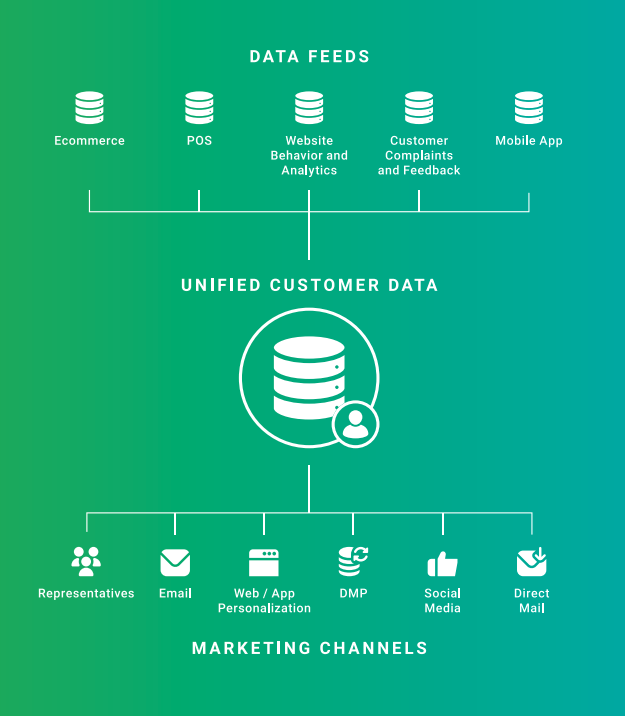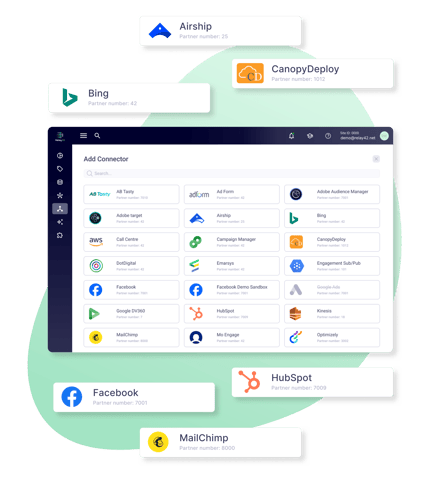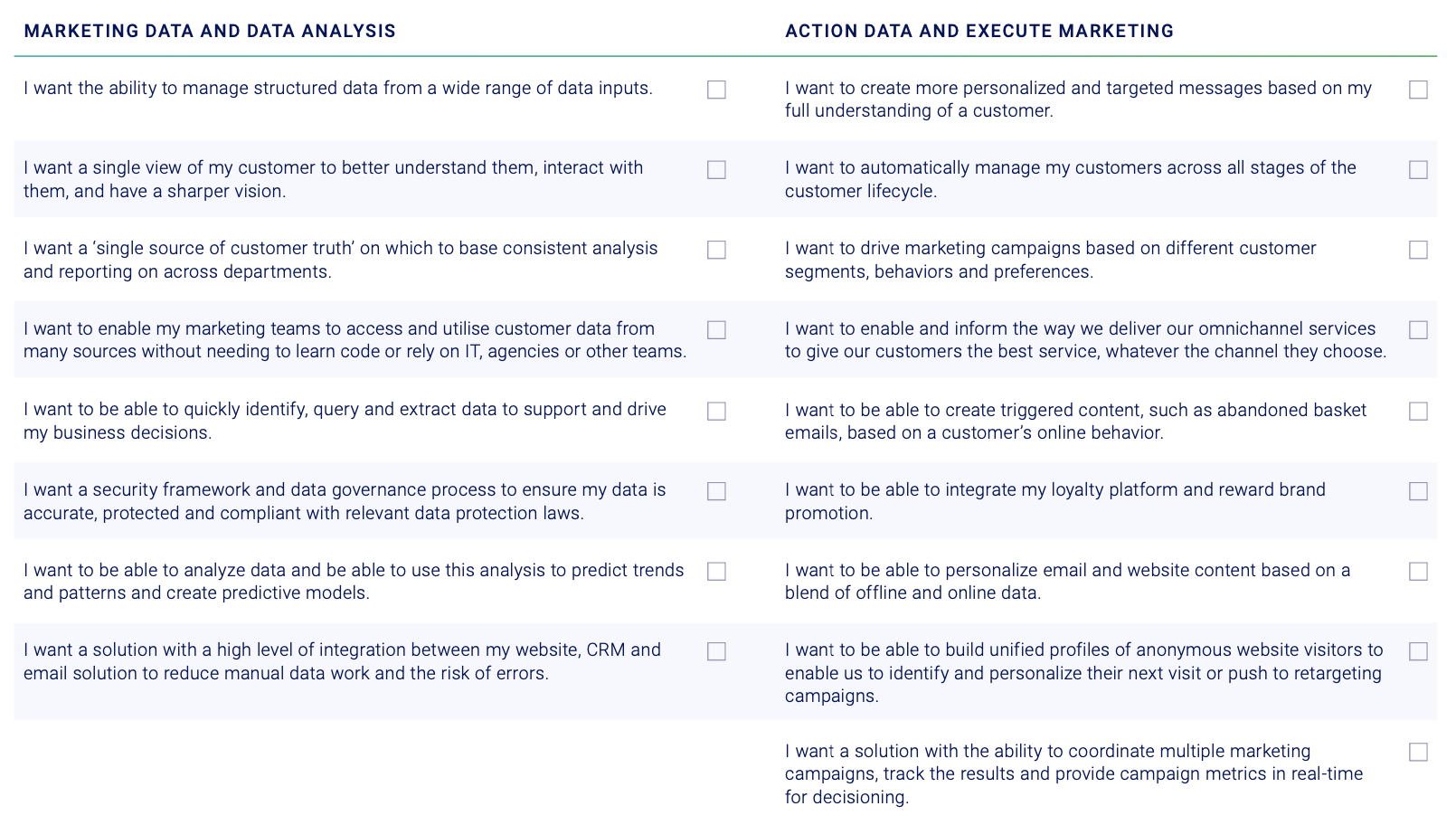What is a Customer Data Platform? A 2025 Comprehensive Guide
From basic capabilities to advanced use cases, this guide explains how CDPs differ from other data management tools, the benefits associated with a unified view of the customer, and offers best practices in choosing and implementing the right CDP for your goals.

Types of Customer Data Collected by CDPs
What Are the Key Customer Data Platform Use Cases?
What A CDP Is Not?
How Does a CDP Help with Data Compliance?
Implementing a CDP: Best Practices
Challenges and Considerations When Choosing the Right CDP
TABLE OF CONTENTS
- What Is a Customer Data Platform (CDP)?
- What A CDP Is Not: Understanding Distinctions Between a CDP vs. CRM, DMP, and a Data Warehouse
- What Does a CDP Do?
- Why Does Customer Data Matter?
- Why Do You Need a CDP?
- Who Uses a CDP, and Why?
- How Does a CDP Work? Key Features of a CDP
- Variations of CDPs
- Types of Customer Data Collected by CDPs
- What Are the Key Customer Data Platform Use Cases?
- How Does a CDP Help with Data Compliance?
- Implementing a CDP: Best Practices
- Challenges and Considerations When Choosing the Right CDP
1. What is a customer data platform (CDP)?
CDP, is a software solution that centralizes customer data from various sources, creating a unified, 360-degree view of each customer.
The CDP Institute defines a CDP as “packaged software that creates a persistent, unified customer database that is accessible to other systems”, and Gartner says that a CDP ‘’enables customer modeling and optimizes the timing and targeting of messages and offers’’.
However, while the core functionality of a CDP is to create these unified customer profiles (sometimes referred to as a ‘Single Customer View’), many CDPs have added functionality and capabilities that go beyond the assembly of customer data.
Adjacent capabilities can often include audience segmentation, journey orchestration, predictive analytics/machine learning, multi-channel campaigns, website personalisation and many more capabilities that were previously associated with marketing automation and campaign management tools.
Similarly, marketing automation, marketing cloud and campaign management tools are launching CDP capabilities of their own, resulting in a lot of choice (and confusion) for businesses when looking to achieve the elusive Single Customer View.

2. What Is Not a CDP?: Differences Between a CDP vs. CRM, DMP and a Data Warehouse
All marketers would agree that it can be challenging to keep up with new technologies – particularly with the proliferation of buzzwords, acronyms and when many vendors claim to do a similar thing. As such, it is worth clearing up the differences between CDPs and some of the other solutions they are most commonly confused with.
CDP vs. CRM: What's the Difference?
Customer Relationship Management (CRM) systems compile and consolidate data from customer interactions with company touchpoints (website, telephone, mail, live chat, social media, etc.), to help businesses manage relationships with their customers and prospects.
CRMs give businesses visibility of customer contact information and sales opportunities. Some have the ability to automate marketing campaigns to those customers. They help with lead nurturing, customer retention, and for up-selling to existing accounts. Unlike a CDP, marketers are not the primary users of a CRM.

How is it different from a CDP?
A CRM compiles customer data and helps optimize a company’s interactions with its known customers. However, if a customer is ‘unknown’ (as in, you hold data about them but it’s in a system or data point your CRM doesn’t refer to), a CRM cannot identify them or engage with them.
A CDP, on the other hand, can identify customers (and new prospects) from many different data sources and, importantly, unify that data into a single, persistent record. Data collected by a CRM is not treated to a Single Customer View process, meaning customer records are not matched, merged or deduplicated.
As a contract management solution, CRMs can be used to view as much data as possible about an individual record. A Customer Data Platform, on the other hand, can handle large volumes and types of data, integrate it, and make it usable to orchestrate cross-channel communications.
It can personalize customer experiences at scale, while CRMs are better suited for salespersons to manage their accounts. Like a DMP, a CRM can be included as an input channel of a CDP, providing data that can improve a company’s ‘golden record’.
CDP vs DMP: What’s the Difference?
DMPs are built to manage cookies data. It is a platform that ingests, collates and stores first-party (the data a business collects about its own customers and visitors) and third-party audience campaign data from external online, offline and mobile sources.
It makes refined audience segments usable by other platforms to place display ads and customized ad content. It allows users to create highly targeted adverts, personalizing the online experience to specific audiences of people based on their demographic, psychographic and behavioral data.

How is it different from a CDP?
While both DMPs and CDPs manage customer data, they have different functions. DMPs use aggregated (mostly third-party) data to target anonymous cookies for advertising and retargeting strategies. CDPs use first-party data (an organization’s own customers), combining online and offline data (often enhanced with third-party data), to deliver personalized experiences, across many marketing channels.
A DMP creates lookalike audiences using anonymous digital identifiers from across the web, gathering data about their interests based on their internet browsing behavior. As a CDP works with ‘known’ individuals, it can create one-to-one treatments for many different types of marketing, like personalized web pages, emails, offers and more.
As one focuses on real, personally identifiable customers and the other on anonymous customers, CDPs and DMPs often work very well together and companies may consider using both.
Essentially, DMPs deal with anonymous data for advertising, while CDPs create detailed customer profiles for more targeted and personalized marketing efforts. You should note that in 2024, DMPs are becoming obsolete due to increased regulation around personal data.
CDP vs. Data Warehouse: What’s the Difference?
A data warehouse is a central repository of large amounts of business information from multiple data sources.
Data warehouses contain data from sales, marketing, purchasing, finance, and other business functions. They help organizations to store and manage data static and factual, making data easier to find, access and use – while they are not equipped to capture large amounts of online interactions and cannot activate customer data in real-time like CDPs.

How is it different from a CDP?
The main differences between a data warehouse and a CDP are the scale, and the purpose. As data warehouses store all corporate data, this typically makes them large, expensive, IT-driven (and IT owned) projects designed to serve analysis for the whole enterprise.
A CDP, as the name suggests, is interested only in customer data, built for the needs of marketers and operated by them. A data warehouse does not include cross channel identity resolution for the creation of a Single Customer View, nor do they support real-time updates or access.
This means marketers cannot extract and use the data they need as quickly as if they were using a CDP.
With marketing teams usually not predisposed to writing technical code or running SQL scripts to extract and manipulate data from a Data Warehouse or from internal systems, it usually results in marketers leaning on their IT, Data Science or agency teams to perform Extract, Transform & Load (ETL) processes to ensure they have the data they need when they need it.
This however results in stress on those internal IT or Data Science teams or increased cost with the agency, and therefore bottlenecks in the overall process.
The CDP therefore enables nontechnical business users to perform advanced data management tasks without the need to upskill in database management, ETL or SQL knowledge, and therefore be nimbler with their campaign lifecycle.
3. What Does a Customer Data Platform Do?
Think of what a CDP does as spring cleaning – collecting every single piece of customer data (from your CRM, transactions and all interactions that customers leave on your website) and getting rid of excess clutter and duplicate items, and organizing your home so it serves your household (your business and teams) and the guests (the customers) better.
In more technical words, a CDP collects, organizes, and unifies customer data from various sources — and creates a single, comprehensive view of each customer. It consolidates data from online and offline channels, such as websites, emails, mobile apps, social media, in-store interactions and many others. This data is then made accessible to other marketing systems, enabling personalized and targeted marketing strategies.
Let’s take a look at what a CDP does step by step:

.png?width=441&height=500&name=Profiles%20(4).png)
.png?width=441&height=500&name=3%20-%20Audience%20Segmentation%20(4).png)
.png?width=2408&height=2728&name=AI%20(2).png)
.png?width=441&height=500&name=2%20-%20Audience%20Segmentation%20(1).png)
4. Who Uses a CDP, and Why?
Customer Data Platforms sit within the category of MarTech solutions, and therefore are primarily used by marketing teams. Typically, a business empowers their digital marketing staff with a CDP to automate marketing workflows to achieve better personalization and segmentation in campaigns.
Marketers need to access, manipulate and use data, rather than rely on a third-party marketing services provider or acquire IT resources. They need to analyze and activate customer data and create targeted, relevant campaigns. More importantly, they need to be able to do this in the space of minutes, not wait hours or days for their requests to be processed by someone else.
Other CX departments like sales, customer service, IT and data teams, and product development may also use a CDP however; especially in companies where personalization and customer experience are core business functions and utmost priorities.
.png?width=422&height=550&name=Untitled%20design%20(54).png)
5. Why Does Customer Data Matter?
.jpg?width=666&height=800&name=toa-heftiba-oMMpTZ8ViDA-unsplash%20(1).jpg)
To deliver great personalization marketers need to have the necessary customer data at their disposal to power the recommendations,dynamic messages and/or offers, but inherently the data that marketers need is not always readily available.
A good example is where today’s interactions on the website, or a complaint into the customer service team, is not picked up quickly enough ahead of a promotional campaign going out in the afternoon. Where the website interactions are siloed in one place, and the CRM data has no immediate way to influence a planned campaign or customer journey, the result is an email offer that is not relevant for that specific customer.
By bringing this data together in real-time and establishing the right triggers and personalization rules, CDPs enable marketers to work more effectively with all the customer data in the business to better personalize experiences at scale.
Four reasons why providing the marketing teams should have a CDP:
1. Consumers Have High Expectations
Consumer expectations for customer experience are higher than ever, but delivering personalized 1-to-1 experiences is difficult for large brands with huge volumes of customers.
Customer experience leaders like Levi’s, FedEx, and KLM Airlines have raised the bar where personalized, relevant experiences are the standard. Implementing hyper-personalization is only possible with comprehensive customer data to power the personalized offers, channel preferences, and to make real-time decisions.

2. Privacy Means More to Customers than Ever
With the advent of privacy regulations such as GDPR, customers are more and more cautious about who they trust with their personal information.
They demand transparency and control over their data, and are more likely to engage with brands that prioritize their privacy. Investing in unifying, structuring and securing your customer data not only helps meet these expectations, but also builds trust and loyalty – as it demonstrates a commitment to protecting your customer’s privacy.
3. Customer Data Silos Cost the Business Money
When marketing teams attempt to deliver an omnichannel, personalized experience without access to unified customer profiles they will encounter some complex data access issues.
This inevitably leads towards internal projects to utilize IT resources to pull data from the Data Warehouse, run some processes and scripts to unify some data sets from other operational systems, and ultimately run some ETL processes to provide the marketing team with what they need.
Of course, with many businesses having as many channels and MarTech/AdTech tools, each holding a fragment of information about a customer, this usually is a good business case for investing in a CDP to eliminate the costly internal processes.
4. Customer Acquisition Costs Are Rising
Meeting high consumer expectations across multiple channels requires significant investment in all types of resources - time, money, human, and more. Getting high audience reach is becoming tougher, CPAs are rising year-on-year, and the need for robust and trustworthy first-party data has never been more necessary than now.
Having fragmented data silos is just not an option as it will slow businesses down, and they will be overpaying for media, and gaining sub-optimal results. Without data to identify the most effective channels and avoid misdirected outreach, brands face high customer acquisition costs. Hence, customer data is essential to maximizing ROI and minimizing unnecessary spending.

Improved Data Compliance
- Usage tracking & right to be forgotten
- Data field screening
- Streamlined data Subject Access Request (SAR) responses
- Audit trail of marketing permissions
Integrated Disparate Channels
- A sound basis for creating and using predictive models
- Build omnichannel customer journeys
- Continual feedback loop from campaigns to refine future messaging
- Create triggered campaigns
Improved marketing efficiency
- Increased customer acquisition
- Reduced customer churn
- Higher average order values
- Increased marketing engagement
- Improved campaign ROI
- Cost savings through more efficient analysis of data
- Human error at the data processing stage can be mitigated

Improved Customer Experience
- Right message, at the right time
- Create targeted and personalized communications
- More consistent, satisfying customer experiences
Ownership of Marketing Data
- Reduced time to understand and activate data
- Greater campaign volume
- Deeper customer segmentation
7. Variations of CDPs

If you wish to discover the types of CDPs further, read this blog.
Evaluating CDPs? Refer to this ebook.
Data CDPs
The basic CDPs that are primarily focused on collecting and organizing customer data from multiple sources. Ideal for organizations that need to consolidate customer data without extensive analytics or activation capabilities.
Analytics CDPs
This type of CDPs provide advanced analytics and customer insights. Analytics CDPs go beyond data aggregation to offer in-depth data analysis and predictive modeling, and they are most suitable for organizations that want to leverage data for more advanced analytics.
Campaign CDPs
Campaign CDPs focus on campaign execution – equipped with tools to activate customer data, so that marketers can target various audiences with messages that resonate with them. They often integrate with other marketing automation platforms.
Delivery CDPs
Delivery CDPs are designed to serve personalized experiences across multiple platforms, enabling cross-channel orchestration and real-time interaction with customers.
8. How Does a CDP Work? Key Features of a CDP
To be classified as a CDP the technology needs to conform to the following criteria.
Ultimately, both options enable the delivery of personalized marketing campaigns, customer service enhancements, and other customer-focused initiatives. The activated data can be used across both owned and paid channels, ensuring consistent and relevant interactions with customers.
1. Create a unified, persistent database
A CDP unifies customer data from disparate business systems. This can include, but is not limited to, your CRM, PoS, mobile data, transactional data, website data, email data, third-party data, legacy systems, etc.
Persistent means that the CDP stores its own copy of the data, rather than shuffled between applications that do not store the data themselves. This database brings together this siloed data, where it undergoes processing to bring data together from disparate sources into a unified database, forming linkages on customers from these separate systems.

2. Accessible to external systems
This means the Customer Data Platform is vendor-neutral, easily leveraged by external systems to use in their own processes. For example, the CDP provides data to build campaigns and models, the data for rules-based personalization on web and mobile, and manages the customer profile database used for creating campaigns, sending emails and displaying ads. It can also supply accurate, unified customer data to CRM systems. Equally, the data can be surfaced to the operational systems that need it.
In addition to these core capabilities, a CDP should also have the following features to serve the marketing teams in the best way possible.
Data Treatments
The collected data in the CDP will also undergo some standardization to ensure accuracy and consistency, remove duplicate entries, and transform or normalize data into a format that the end users can understand and utilize.
Identity Resolution
The CDP uses logic to locate and match identifiers from different data sources to create unified customer profiles. This process involves linking unique data points such as email addresses, phone numbers, and device IDs to the same individual.
Segmentation
Once unified profiles are created, the CDP allows you to segment their audiences based on various attributes. The segmentation can be as detailed as the marketing team defines and specify what you need for your marketing channels.
Analytics and Insights
The CDP is an agnostic place for predictive analytics and machine learning models to be used on the data to predict better outcomes. Furthermore, using analytical tools inside the CDP, or by connecting to a BI solution, the business can start to utilize more trustworthy and consistent data for all customer intelligence needs.
Data Activation
Finally, CDP’s provide the ability to activate the data. Some CDPs provide campaign management and journey orchestration functionalities to centralize CX decisions across channels in a workflow-driven way, while others simply focus on giving you the ability to push segmented audiences to your channels where the CX decisions are then made in the channel tools.
9. Types of Customer Data Collected by CDPs
Demographic Data
Personal customer information such as age, address, phone number, email, gender, interests, values, lifestyle preferences, etc.
Behavioral & Engagement Data
Data showing browsing history, purchase history, interactions from ads and second-party data partnerships, email opens, clicks, social media interactions, etc.
Transactional Data
Data regarding purchase transactions, channels transacted through, purchase prices, discounts, order history, etc.
10. What Are the Key Customer Data Platform Use Cases?
Once you have all your customer data unified and accessible in the CDP, the possibilities for what to do with that data are endless, resulting in hundreds, if not thousands, of potential use cases that a CDP can enable, but here are some of the most common ones that will help you understand the value of CDPs in a nutshell.
Identifying opportunities for cross-selling and upselling by understanding customer preferences and purchase history, driving additional revenue.
Example: A home goods store uses purchase history and browsing data to identify cross-sell and upsell opportunities. For instance, if a customer buys a coffee maker, the store sends follow-up emails suggesting premium coffee beans, mugs, and filters, driving additional revenue.
Creating detailed customer segments based on behaviors, preferences, AI predictions, and demographics to enable more precise targeting and tailored marketing efforts.
Example: A skincare brand segments its customers based on skin type, age, purchase history, and geographic location. They then create targeted marketing campaigns, such as anti-aging products for older customers and acne solutions for younger customers, ensuring that each segment receives the most relevant information and offers.
Enhancing e-commerce and retail experiences by using customer data to provide personalized recommendations, boosting sales and customer satisfaction.
Example: A fashion retailer uses customer data to offer personalized product recommendations on their website. When a customer views a particular dress, the site suggests complementary items such as shoes and accessories, which leads to higher basket values and customer satisfaction.
Utilizing advanced analytics and machine learning to predict customer behavior, identify trends, and uncover actionable insights for proactive decision-making.
Example: An online bookstore uses machine learning to analyze purchasing trends and customer preferences. They predict which books customers are likely to buy next based on their reading history and send personalized recommendations before a customer even starts looking for their next read, thereby increasing sales.
Ensuring a seamless and consistent customer experience across all channels, including online, mobile, in-store, and customer service, by providing a unified view of customer interactions and enabling cross-channel decisions and cooperability.
Example: A utilities provider integrates data from their website, mobile app, in-store purchases, and customer service interactions. By providing a unified view of customer interactions, they ensure that customers receive consistent service and recommendations whether they call customer support, or interact via other channels.
Identifying high-value customers, eliminating redundant or ineffective marketing efforts, and focusing ad spend on the most promising segments. This results in more efficient use of advertising budgets, reducing waste on less relevant audiences, and ultimately decreasing overall ad spend while maintaining or even improving marketing effectiveness.
Example: An automotive company targets customers with an advert on social media after they review a car catalog. The messaging includes specific car models that have caught the attention of the customers. When they click on the targeted ad it takes them to a personalized landing page which then leads them to an appointment with an automotive salesperson.
Analyzing the effectiveness of marketing campaigns and channels, and optimizing strategies based on data-driven insights to maximize ROI.
Example: A beverage company analyzes the performance of its recent ad campaigns across social media, email, and in-store promotions using data-driven insights from a CDP. They identify which channels and messages had the highest engagement and conversions, reallocating their budget to maximize ROI for future campaigns.
Understanding and optimizing the entire customer journey by tracking interactions across multiple touchpoints, enabling businesses to deliver consistent and relevant experiences.
Example: A travel agency tracks customer interactions from initial website visits, app usage, booking confirmations, and post-trip feedback. By mapping this journey, they identify key touchpoints where customers seek more information and tailor their communication strategy to provide timely and relevant updates, improving overall customer satisfaction.
Leveraging unified customer data to create and deliver highly personalized marketing messages and offers across various channels, increasing engagement and conversion rates.
Example: An airline company uses a CDP to analyze customer purchase history and browsing behavior. For a frequent business traveler who flies in and out between London and Amsterdam, they offer a convenient, bundle package that includes fast check-in and a delicious sandwich that the customer often purchases on board.
Ensuring compliance with data privacy regulations by maintaining accurate and up-to-date customer data, and managing customer consent and preferences effectively.
Example: A financial services firm ensures compliance with GDPR by using a CDP to manage customer consent and preferences. They maintain accurate and up-to-date customer data, automatically updating preferences across all systems when a customer opts out of marketing communications, thus avoiding legal pitfalls.
Identifying at-risk customers and implementing targeted retention strategies, as well as optimizing loyalty programs based on comprehensive customer data.
Example: A subscription box service identifies customers whose engagement is declining by analyzing usage patterns and feedback. They then send personalized retention offers, such as discounts or exclusive products, to these at-risk customers and also optimize their loyalty program based on customer data to keep members engaged.
11. How Does a CDP Help with Data Compliance?

Having a CDPs has a direct and positive impact on your organization’s compliance, in that a CDP centralizes scattered and siloed data together. This makes it easier to track, audit, and control data in compliance with regulations.
In addition, CDPs can include tools to manage customer consent and preferences. They centralize when and how consent was obtained from each channel and ensure that marketing activities are aligned with the customer's expressed preferences, which is crucial for regulations like GDPR and CCPA.
Many EU-based CDPs are built with privacy-by-design principles. They incorporate features such as data minimization, purpose limitation, and data anonymization or pseudonymization to protect personal data throughout its lifecycle. That is why CDPs come in handy when it is time for auditing and reporting. The detailed logs and governance of how customer data is being used and changed over time is vital for demonstrating compliance during regulatory audits and for internal governance purposes.
Finally, leading CDP providers frequently update their platforms to adapt to new regulatory requirements and offer compliance features. A CDP is therefore helpful when ensuring that your business is aligned with evolving data protection laws.
12. Implementing a CDP: Best Practices
Start with Stakeholder Management
An important CDP best practice is to define who will be impacted by the CDP at your organization. Start by establishing a team of CDP stakeholders from marketing, sales, IT, and other relevant departments. Make sure that your team fully understands the role of your new customer data platform, why it is being purchased and used, what value it will bring to your business, and what this means for the teams that will closely engage with the CDP.
Integrations Matter
Make sure that your chosen CDP offers seamless integration of data from all sources, including online and offline channels. This is a significant step that you wouldn’t want to sleep on, especially if you want to ensure that all customer data coming from all of your channels is being worked with. Do not limit yourself to integrating one or a few data sources – get as many (relevant) customer data sets as possible to create robust profiles.
Define Clear Goals
To get the best out of your CDP, you will want to start by defining clear goals, objectives, vision, roadmap and outcomes that you want to achieve with this new addition to your existing tech stack. Simultaneously, invest in resources to elevate your data hygiene. This way, you’ll realize the power of your CDP better in the next stages of implementation. Understand the ins and outs of the dataset you are bringing into the CDP to avoid inaccurate profile creation in the future.
Develop Use Cases
Well-defined use cases are crucial when selecting and implementing a CDP, as they serve as specific scenarios that demonstrate how the CDP should support your business objectives, helping you to challenge potential CDPs to see which can deliver the functionalities you need.
This will lead you to create a clear framework for evaluating different CDP solutions, and reduce the risk of investing in a platform that may fall short.
13. Challenges and Considerations when choosing the right CDP
When choosing the right customer data platform, make sure that your CDP team aligns on the scoring criteria for vendor evaluation by looking at client history, executions, and vendor support capabilities. During CDP demos, ask vendors to demonstrate solutions for your key use cases and potential challenges. Ensure you collect RFP responses before setting up demos to disqualify unsuitable vendors early.
Organizations often desire a Customer Data Platform solution to approach the following challenges. Here are common requirements we see from businesses. Lay this out on the table with your team, and check each box that resonates with your marketing challenges at the moment.

Frequently Asked Questions
CDPs analyze vast amounts of customer data and identify patterns and trends. AI and ML algorithms enable the CDP to predict customer behavior, segment audiences more precisely, and personalize marketing efforts effectively.
Predictive analytics help in forecasting customer needs and preferences, enabling proactive engagement strategies. These technologies also assist in optimizing marketing campaigns, improving customer retention, and driving higher conversion rates by delivering timely and relevant content.
CDPs enable omnichannel customer experiences by unifying data from all customer touchpoints, providing a comprehensive view of each customer. This unified data allows for consistent and personalized interactions across channels such as email, social media, web, and in-store. Real-time data synchronization ensures that customer interactions are updated instantly, allowing for seamless transitions between channels.
CDPs support personalization at scale by consolidating customer data from various sources to create unified profiles. These profiles enable marketers to segment audiences accurately and deliver tailored messages across multiple channels. Real-time data processing allows for dynamic personalization based on current customer behavior. This ensures consistent, relevant experiences for each customer, enhancing engagement and loyalty.
Implementing a CDP typically takes a few months to over a year, depending on the complexity of data integration and the quality of existing data. The scope of the project, including the number of use cases and involved departments, also affects the timeline.
Additionally, the availability of internal resources and the level of customization required can impact the duration.
See Relay42 in Action
Experience a first-hand tour of the Relay42 Customer Data Platform with one of our consultants

